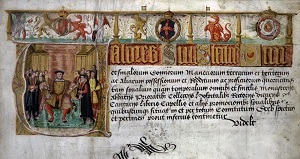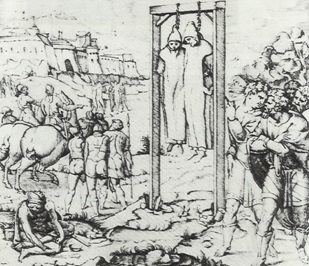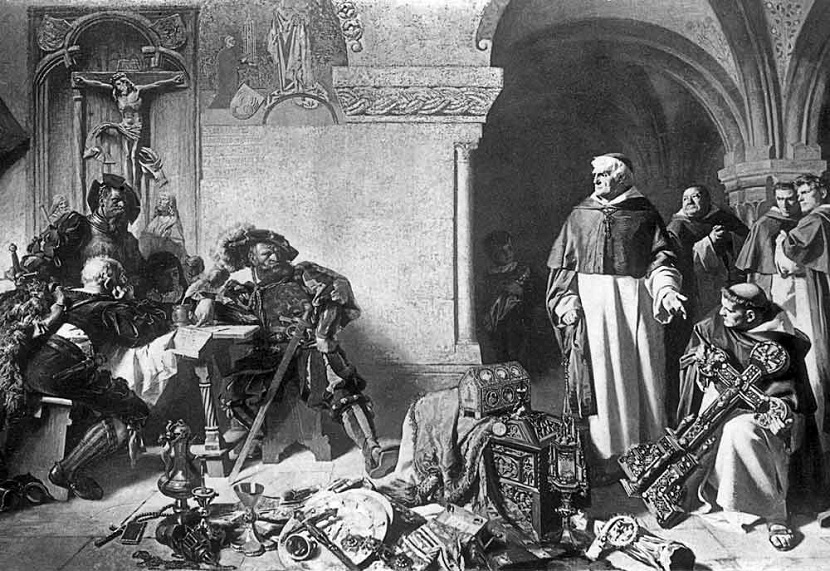
The Dissolution of the Monasteries

Introduction
After Henry had made himself Supreme Head of the Church, he decided to close down the monasteries. This is called the 'dissolution' of the monasteries.
There were many reasons for this. All priests and monks had promised to obey the Pope, so Henry was afraid that he would not be able to rely on their loyalty. It was also true that the monasteries were becoming out of date. In the Middle Ages, monks had been very useful. They had copied books, taught children, cared for the sick, sheltered travellers, and given money to the poor. But times had changed. The printing press had been invented. There were more schools, hospitals and inns. Most people no longer needed the monasteries.
Also, for centuries, people had given land and money to the monasteries, hoping that this would earn them a place in heaven. The Church owned one quarter of all the land in England. The monasteries had great wealth. One modern historian thinks:
... this was probably Henry's main reason for closing the monasteries.
Peter Moss, History Alive 1 (1968)
 In 1535, Henry told Thomas Cromwell to arrange a report on the monasteries.
In 1535, Henry told Thomas Cromwell to arrange a report on the monasteries.
It was called the Valor Ecclesiasticus (meaning 'what the Church is worth').
Monks and nuns were supposed to be poor. They had promised to spend their lives working and praying. They were not supposed to have sexual relations.
But the Valor Ecclesiasticus included many reports about places where monks and nuns were behaving badly (see sources 1-4).
Peter Moss writes:
Cases like this were not frequent ... but they gave Henry an excuse.
Between 1536 and 1539, Henry closed down nearly 825 monasteries and nunneries. He took their wealth. Henry became the richest king in Europe.
The people who did best out of the dissolution were the emerging middle classes – the rich country gentry and lawyers. They bought, or were granted, most of the land the monasteries lost. They became important ... and had a powerful reasons to support the king's supremacy (without it, they would not have their land and wealth).

But ten thousand monks and nuns were made homeless. Monks were not badly treated. Most became village priests. Nuns were less well treated. They could not become priests, and they were given only a robe. Many were forced to become servants or beggars.
This engraving of 1564 by the French (Catholic) Nicolas Beatrizet shows two of the Carthusians monks who were executed for refusing to swear that Henry was Head of the Church. Notice the beggar; because the monasteries have closed he has nowhere to go for food or money.
After you have read studied the Sources below, answer the question sheet by clicking on the 'Time to Work' icon at the top of the page.
Links:
The following websites will help you research further:
Dissolution of the
Monasteries:
•
History Learning site • S-Cool notes
• Detailed overview from
St Hugh's School
1 Peterborough Monastery
Sources 1-5 are reports by the inspectors who Thomas Cromwell sent to the monasteries and nunneries in 1535. He told the inspectors to go also to the local inns, to collect gossip about the monks and nuns.
The lord abbot does not choose studious monks but looks for lazy ones. There is a tavern where the brothers drink in bad weather.... The sacrist of the monastery has in his bedroom secretly a certain maiden named Joan Turner.
2 Bury St Edmunds Monastery
The abbot loved to play dice and spent much on it. He did not preach in public. There was a frequent coming and going of women to the monastery.
3 Ramsey Monastery
Many of the monks devote themselves to hunting and other sports.... The dormitory is so neglected that rain falls on the brothers' beds.... The prior is frequently drunk.
4 Glastonbury Abbey
When the abbot's answers were not to our purpose we ... searched his study and found ... a written book against the divorce of the King.
5 Bury St Edmunds Nunnery
I could not find out anything bad about the nunnery no matter how hard I tried. I believe everybody had got together and agreed to keep things secret.
6 The Dissolution of the Monasteries
How has the artist of this 19th century painting interpreted the dissolution? Whose side was he on? How can you tell?
